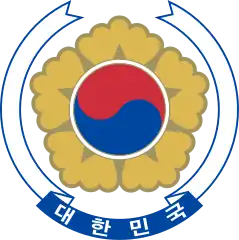South Korea–United States relations
Diplomatic relations between South Korea and the United States commenced in 1950, when the United States helped establish the modern state of South Korea, officially the Republic of Korea, and fought on its UN-sponsored side in the Korean War (1950–1953). During the subsequent decades, South Korea experienced tremendous economic, political and military growth.
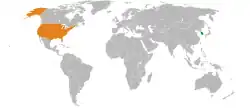 | |
South Korea |
United States |
|---|---|
| Diplomatic mission | |
| South Korean Embassy, Washington D.C. | United States Embassy, Seoul |
| Envoy | |
| Ambassador Cho Tae-yong | Ambassador Philip Goldberg |

South Korea has a long military alliance with the United States, aiding the U.S. in every war since the Vietnam War, including the Iraq War.[1] At the 2009 G20 London summit, then-U.S. President Barack Obama called South Korea "one of America's closest allies and greatest friends."[2] In 1987, South Korea was among the first batch of countries to be designated as a major non-NATO ally.[3][4] In June 2023, South Korean President Yoon Suk Yeol said that he had upgraded the country's alliance with the United States to one that is "nuclear-based" in the face of North Korea's growing military threat.[5]
By 2014 several security factors were shaping the alliance:
- The challenges posed by North Korea's nuclear and missile program and the potential of weapons proliferation to other states,
- The impact of peace and reunification developments on the Korean peninsula on the strategic relationship between the United States and China
- The potential impact of events on the Korean peninsula on Japan and Sino-Japanese rivalry.[6]
South Korea is currently one of the most pro-American countries in the world. According to a 2018 Pew survey, 77% of South Koreans had a favorable view of the United States, while 21% had a negative view.[7] According to a 2018 Gallup poll, 77% of Americans had a favorable view of South Koreans, while 22% had a negative view.[8]
However, signs indicate S.K.-U.S. relations may be simultaneously strengthening, as cultural exchange[9] (see also TALK program), developments in media partnership (See Parasite Oscar win),[10] and a strong trade in goods and services[11] continues. South Korea is also a top destination of U.S. military hardware, with a recent deal in August 2019 for Seahawk helicopters topping 800 million dollars.[12]
Country comparison
Leaders of South Korea and the United States from 1950

Historical background
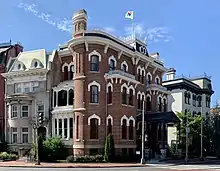
Following the United States expedition to Korea in 1871, the United States and Joseon established diplomatic relations under the 1882 Treaty of Peace, Amity, Commerce, and Navigation. However, Japan assumed direction over Korean foreign affairs in 1905 and in 1910 began a 35-year period of colonial rule over Korea.[13]
In 1945, at the end of World War II, Japan surrendered to the Allies and the Korean Peninsula was divided at the 38th parallel into two occupation zones, with the United States in the South and the Soviet Union in the North. Initial talks in 1945–6 to achieve a unified, independent Korea were not successful, and in 1948 two separate nations were established: the Republic of Korea (ROK) in the South, and the Democratic People's Republic of Korea (DPRK) in the North. On January 1, 1949, the United States officially recognized the Republic of Korea as the sole legitimate government of Korea and established diplomatic relations on March 25 of that year.[13][14]
Korean War (6.25 War)
Cross-border skirmishes and raids at the 38th Parallel escalated into open warfare when the North Korean forces invaded South Korea on June 25, 1950.[15] In response, 16 member countries of the United Nations, including the United States, came to the defense of South Korea. It was the first significant armed conflict of the Cold War with extensive deployment of U.S. and other troops.[16]
… About 37,000 Americans lost their lives. They fought for the freedom of Koreans they did not even know, and thanks to their sacrifices, the peace and democracy of the republic were protected. … On this significant occasion, all Koreans pay tribute to the heroes fallen in defense of freedom and democracy. I firmly believe that future generations in both countries will further advance the strong Republic of Korea–U.S. alliance into one befitting the spirit of the new age.[17]
Los Angeles Times, June 25, 2010
Origins of the South Korea–United States alliance
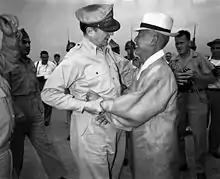
Following the end of World War II, the United States established a bilateral alliance with South Korea instead of establishing a multilateral alliance with South Korea and other East Asian countries.
Moreover, the "U.S. alliance with South Korea would consequently have three functions. First, it would serve as part of a network of alliances and military installations designed to ring the Soviet threat in the Pacific. Second, it would deter a second North Korean attack, with U.S. ground troops serving as the "tripwire" guaranteeing U.S. involvement. Third, it would restrain the South from engaging in adventurism."[18]
The United States and South Korea are allies under the 1953 Mutual Defense Treaty. Under the agreement, U.S. military personnel have maintained a continuous presence on the Korean peninsula.
US military in Korea
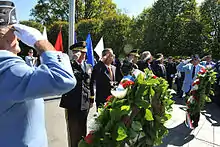
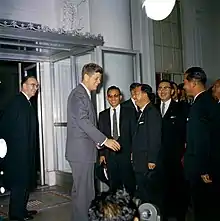
South Korea and the United States agreed to a military alliance in 1953.[19] They called it "the relationship forged in blood".[20] In addition, roughly 29,000 United States Forces Korea troops are stationed in South Korea. In 2009, South Korea and the United States pledged to develop the alliance's vision for future defense cooperation.[21] Currently, South Korean forces would fall under United States control should the war resume. This war time control is planned to revert to South Korea in 2022.[22]
At the request of the United States, President Park Chung-hee sent troops to Vietnam to assist American troops during the Vietnam War, maintaining the second largest contingent of foreign troops after the United States. In exchange, the United States increased military and economic assistance to South Korea. In 2004, President Roh Moo-hyun authorized dispatching a small contingent of troops to Iraq at the request of U.S. President George W. Bush.[1]
Since 2009, air forces of South Korea and the U.S.A. have conducted annual joint exercises under the name "Max Thunder". In 2018 the drills began on May 11 and continued until May 17.[23]
At a Cabinet meeting in Seoul on 10 July 2018 the government decided not to hold that year's Ulchi drill, scheduled for June 2018. The Government said the decision was made in line with recent political and security improvements on the peninsula and the suspension of South Korea-U.S. joint military exercises.[24]
Former South Korean President Moon Jae-in, elected in May 2017, has said he supports the continuation of sanctions against North Korea if it is aimed at bringing North Korea out of its state of isolation and to the negotiating table. He also argued, at the same time, that he was against a "sanctions-only" approach toward North Korea.[25] His approach to North Korea is similar to Kim Dae-jung's Sunshine Policy, which only continued up to the Roh Mu-hyun's administration.
In 2018 there were several rounds of talks regarding sharing the cost of U.S forces in South Korea. These reflect Washington's desire for South Korea to share a "greater burden" of the costs of the military deployment.[26]
On 12 June 2018 during the 2018 Trump–Kim summit, US president Donald Trump and Kim Jong Un signed a Joint Statement which reaffirmed the Panmunjom Declaration.[27]
The US Ambassador to South Korea, Harry B. Harris Jr., arrived in Seoul on July 7, 2018. The post had been vacant since President Donald Trump took office in January 2017. Harris, a former head of the US military's Pacific Command, has expressed his resolve to work as an ambassador to strengthen the alliance between the United States and South Korea.[28]
On February 10, 2019, South Korea and the United States confirmed that a year long deal for keeping American troops, numbering 28,500, in South Korea had been made. This was in exchange for South Korea paying 925 million dollars to the United States.[29]
In terms of American leadership, Bill Clinton and George W. Bush both emphasized the Middle East over North Korea. Clinton had deep emotional ties with Israel but neglected North Korea issues and never built strong personal relations with South Korean leaders. Bush, whose religious fundamentalism led him to divide the world into good and evil, had a personalized hatred for North Korean leader Kim Jong-il, but he also had frosty relations with South Korean leaders.[30]
In his 2021 New Year’s press conference on January 18, President Moon Jae-in stated that the two Koreas might be able to discuss the U.S.-South Korea military drills through a joint inter-Korean military committee. However, U.S. officials expressed that it is not a topic to be decided by Pyongyang, and that scaling down the exercises was not desirable.[31]
.jpg.webp)
In May 2022, President Joe Biden and President Yoon Suk Yeol agreed in talks to begin discussions on restarting and potentially expanding joint military training on and around the Korean Peninsula. The move was a signal that Biden was changing course from former President Donald Trump's positions in Asia.[32]
In April 2023 a visit by Yoon to Washington produced a nuclear deterrence plan aimed at North Korea. Joe Biden said the deal allowed nuclear submarines to dock in South Korea. This capability had not been seen since 1991. Biden said: "A nuclear attack by North Korea against the United States or its allies and partners is unacceptable, and will result in the end of whatever regime were to take such an action." The so-called Washington Declaration came after nearly 50 years had passed since Korea signed the Nuclear Non-Proliferation Treaty and gave up its nuclear ambitions.[33][34][35]
Nuclear and missile diplomacy

Between 1958 and 1991, the United States based a variety of nuclear weapons in South Korea. The number reached a peak of 950 warheads in 1967. Since 1991, when President George H. W. Bush announced the withdrawal of all tactical nuclear weapons based abroad, the Korean peninsula has seen ongoing efforts by the U.S. to negotiate an end to North Korea's own nuclear and missile development. These efforts have been characterized by "stalemates, crises and tentative progress." Despite the ongoing tensions, the U.S. has not redeployed nuclear weapons, although one recent press report suggests a majority of South Koreans are in favor of developing their own nuclear weapons. South Korea announced the deployment of the Terminal High Altitude Area Defense anti-ballistic missile defense system at the end of 2017.[36]
Opinion polls
According to Pew Research Center, 84% of South Koreans have a favorable view towards the United States and Americans (ranked within top 4 among the countries in the world).[37][38] Also, according to a Gallup Korea poll, South Korea views the U.S. as the most favorable country in the world.[39] On the political side, the United States supported South Korea after 1945 as a "staunch bastion against communism", even when the ROK itself was ruled by a US-backed dictatorship.[40] In a March 2011 Gallup Poll, 74% of South Koreans said that they believe that the U.S. influence in the world is favorable,[41] and in a November 2011 Gallup Poll, 57% of South Koreans approved of U.S. leadership, with 22% disapproving.[42] In a 2011 Gallup poll, a 65% favorability rating, the highest rating to date.[41]
According to a 2014 BBC World Service Poll, 58% of South Koreans view U.S. influence positively, the highest rating for any surveyed Asian country.[43]
As relations with Korea waxed hot and cold under President Donald Trump, American public opinion regarding North Korea likewise fluctuated sharply, and no clear picture emerges.[44]
Issues and recent history
US military and the sex trade
In 1953, at the end of the Korean War, the number of prostitutes in South Korea was estimated as about 350,000, with about 60 percent working near U.S. military camps.[45] In the post-Korean War period, the U.S military continued to contribute significantly to the South Korean economy, providing an estimated 1 percent of the South Korean GNP in 1991, including the sex industry.[46] Despite the world-wide growth of women's human rights advocacy since the 1990s, and the shift towards foreign workers providing sex services for U.S troops, (particularly women trafficked from the Philippines and the former Soviet Union), prostitution via "juicy bars" remains an issue near U.S. bases in South Korea.[47][48]
1992 Yun Geum-i murder
In 1992, Yun Geum-i, a 26-year-old woman, was brutally killed by a U.S. serviceman, Private Kenneth L. Markle, in Dongducheon.[49][50] In August 1993, the U.S. government compensated the victim's family with a payment of about US$72,000.[51] Markle was sentenced by a South Korean court to life imprisonment, later reduced to 15 years. Professor Katharine Moon notes that the murder was not unique, and did not spark a national debate about the presence of U.S. forces. However, it did become a "call to action" for some Koreans, and led to the establishment of the "National Campaign for the Eradication of Crimes by U.S. troops."
Environmental degradation
In July 2000, the Eighth U.S. Army apologized for an incident where formaldehyde, a toxic fluid, was released into the Han River in February of that year.[52] In a report released in 2017 detailing spill incidents from 1995 to 2015 at the US garrison in Yongsan, South Korean environmentalist groups expressed concern about the lack of transparency and the possibility of continued water contamination, as well as who would take responsibility for cleanup of the site.[53]
Yangju highway incident
On 13 June 2002, two 14-year-old South Korean schoolgirls were crushed to death by a 50-ton United States Army vehicle in Yangju. Anti-Americanism was pervasive after the driver and the navigator of the vehicle were both acquitted in U.S. courts-martial on charges of negligent homicide. There was resentment from protesters towards the U.S.–South Korea Status of Forces Agreement, which restricted South Korea from having jurisdiction over alleged crimes that occurred when American soldiers were on official duty. South Korean presidential candidate Lee Hoi-chang called on United States President George W. Bush to "apologize to soothe the pain of the Korean people and to prevent any escalation in anti-American sentiment". American ambassador to South Korea Thomas C. Hubbard apologized on behalf of Bush.[54]
2008 beef protests in South Korea
The Government of South Korea banned imports of U.S. beef in 2003 in response to a case of mad cow disease in Washington state. In 2008, the protests against U.S. beef recalled the student "pro-democracy" movements of the 1980s. Nevertheless, by 2010 South Korea had become the world's third largest U.S. beef importer. With its strong import growth, South Korea surpassed Japan for the first time to become the largest market for U.S. beef in Asia and in 2016 US beef imports in Korea reached a value of $1 billion.[55][56]
2015 attack on the United States Ambassador
At about 7:40 a.m. on March 5, 2015, Mark Lippert, United States Ambassador to South Korea was attacked by a knife-wielding man at a restaurant attached to Sejong Center in downtown Seoul, where he was scheduled to give a speech at a meeting of the Korean Council for Reconciliation and Cooperation.[57] The assailant, Kim Ki-jong, is a member of Uri Madang, a progressive cultural organization opposed to the Korean War.[58] He inflicted wounds on Lippert's left arm as well as a four-inch cut on the right side of the ambassador's face, requiring 80 stitches.[57] Lippert underwent surgery at Yonsei University's Severance Hospital in Seoul. While his injuries were not life-threatening, doctors stated that it would take several months for Lippert to regain use of his fingers.[57] A police official said that the knife used in the attack was 10 inches (25 cm) long [57] and Lippert later reported that the blade penetrated to within 2 cm of his carotid artery.[59] ABC News summarized the immediate aftermath of the attack as follows: "Ambassador Lippert, an Iraq war veteran, defended himself from the attack. Lippert was rushed to a hospital where he was treated for deep cuts to his face, his arm, and his hand. ... [He] kept his cool throughout the incident."[60]
During the attack and while being subdued by security, Kim screamed that the rival Koreas should be unified and told reporters that he had attacked Lippert to protest the annual United States–South Korean joint military exercises.[57] Kim has a record of militant Korean nationalist activism; he attacked the Japanese ambassador to South Korea in 2010 and was sentenced to a three-year suspended prison term.[61][62][63][64] On September 11, 2015, Kim was sentenced to twelve years in prison for the attack.[65]
Opposition to THAAD
The rollout of the Terminal High Altitude Area Defense (THAAD) has been met with domestic opposition in South Korea. The opposition has been on the grounds that the North Korean threat has gone, and on environmental grounds.[66][67][68][69] THAAD was deployed under the administration of ROK President Park Geun-hye. Her opponents accused her of "bow[ing] too readily to America's requests."[69] According to South China Morning Post, when Prime Minister Hwang Kyo-ahn visited Seongju to appease the local backlash against THAAD, demonstrators blocked Hwang's buses and pelted him with eggs and water bottles. The progressive People's Party also opposes the deployment.[69]
Economic relations
There remains some major trade disputes between the ROK and the US in the areas including telecommunications, automotive industry, intellectual property rights issues, pharmaceutical industry, and the agricultural industry.[70]
South Korea's export-driven economy and competition with domestic U.S. producers in certain fields of products have led to some trade friction with the United States. For example, imports of certain steel and non-steel products have been subject to U.S. anti-dumping and countervailing duty investigations. A total of 29 U.S. imports from South Korea have been assessed.[71]
Cultural exchange
The South Korean government maintains Korean cultural education centers in: Wheeling, Illinois (near Chicago), Houston, New York City, Los Angeles, San Francisco, and Washington, DC.[72]
See also
References
- Len, Samuel; Tribune, International Herald (2004-02-14). "South Korea approves 3,000 troops for Iraq". The New York Times. ISSN 0362-4331. Archived from the original on 2020-09-20. Retrieved 2020-03-06.
- President Obama Vows Strengthened U.S.-South Korea Ties Archived 2009-07-04 at the Wayback Machine 2 Apr 2009. Embassy of the United States, Seoul
- Fisher, Dan (1987-02-16). "U.S. Is Granting Israel Non-NATO Ally Status : Move Should Bring Strategic and Economic Gains, Shamir Says; Egypt Gets Same Rating". Los Angeles Times. Retrieved 2023-05-21.
- "Explained: What is a 'Major non-Nato Ally' status?". The Times of India. 2021-01-04. ISSN 0971-8257. Retrieved 2023-05-21.
- Kim, Jack (2023-06-06). "South Korea's Yoon says alliance with U.S. 'nuclear-based'". Reuters. Retrieved 2023-06-07.
- Shambaugh, David (2014). International Relations of Asia. Rowman & Littlefield. p. 306. ISBN 978-1-4422-2641-8. Archived from the original on 2020-09-20. Retrieved 2020-09-17.
- "Global Indicators Database". Pew Research Center's Global Attitudes Project. Retrieved 2020-03-06.
- Inc, Gallup (2018-02-20). "South Korea's Image at New High in U.S." Gallup.com. Retrieved 2020-03-06.
{{cite web}}:|last=has generic name (help) - Team, Meridian International Center. "Young Professionals and Students from the U.S. and Korea Engage in Cross-Cultural Exchange | Meridian International Center". www.meridian.org. Retrieved 2020-03-06.
- "The Oscars 2022 News, Blogs & Articles | 94th Academy Awards". oscar.go.com. Retrieved 2020-03-06.
- "OEC – South Korea (KOR) Exports, Imports, and Trade Partners". oec.world. Retrieved 2020-03-06.
- Mehta, Aaron (2019-08-08). "South Korea cleared to buy $800M worth of Seahawk helicopters". Defense News. Retrieved 2020-03-06.
- "U.S. Relations With the Republic of Korea". United States Department of State. Archived from the original on 2019-06-07. Retrieved 2019-06-07.
- Gilbert, Martin (1998). A History of the Twentieth Century. London: Harper Collins Publishers. pp. 782–783. ISBN 0002158698.
- Devine, Robert A.; Breen, T. H.; Frederickson, George M.; Williams, R. Hal; Gross, Adriela J.; Brands, H.W. (2007). America Past and Present 8th Ed. Volume II: Since 1865. Pearson Longman. pp. 819–821. ISBN 978-0-321-44661-9.
- Hermes, Walter Jr. (1992) [1966]. Truce Tent and Fighting Front. United States Army Center of Military History. pp. 2, 6–9. CMH Pub 20-3-1. Archived from the original on 2009-02-24. Retrieved 2010-07-06.
- From South Korea, a note of thanks Archived 2018-06-23 at the Wayback Machine June 25, 2010. Los Angeles Times
- Cha, Victor (Winter 2009–2010). Powerplay: Origins of U.S. Alliances in Asia. p. 174.
- The ROK-US Mutual Defense Treaty Archived 2011-01-22 at the Wayback Machine Embassy of the Republic of Korea in the United States
- Speeches of U.S. Ambassador, March 20, 2009 Archived May 28, 2010, at the Wayback Machine
… One of the first phrases I learned in Korean, I heard in Korean, when people talked about the US-Korea relationship, was 혈맹관계, "the relationship forged in blood." I remember how moved I was by that, by the passion which people used in talking about it. Our relationship, as you all well know, goes further back even than that …
(March 20, 2009, U.S. Ambassador in the Republic of Korea) - Joint Statement of ROK-US Foreign and Defense Ministers’ Meeting Archived 2010-07-23 at the Wayback Machine 07-21-2010. The Korea Times
- "US, South Korea Prepare for Transfer of Wartime Operational Control". 18 March 2021. Archived from the original on 2021-06-03. Retrieved 2021-09-30.
- "What is Max Thunder?". BBC News. Archived from the original on 2018-07-08. Retrieved 2018-07-21.
- "Gov't Decides to Suspend Annual Ulchi Drill | Politics/News/News/KBS World Radio". Archived from the original on 2018-07-10. Retrieved 2018-07-10.
- "US and South Korea agree to 'stronger' sanctions against North Korea". Deutsche Welle. September 17, 2017. Archived from the original on October 2, 2018. Retrieved September 30, 2018.
- "S. Korea, U.S. Begin Talks on Sharing Defense Costs l KBS WORLD Radio". Archived from the original on 2018-08-22. Retrieved 2018-08-23.
- Vox - Understand the News - 12 June 2018: Breaking: Trump and Kim sign agreement pledging to work toward "a lasting and stable peace"
- "New US ambassador to S.Korea arrives in Seoul - News - NHK WORLD - English". Archived from the original on 2018-07-10. Retrieved 2018-07-10.
- "South Korea says it will pay a bit more to host American troops". The Economist. 2019-02-16. ISSN 0013-0613. Archived from the original on 2019-02-24. Retrieved 2019-02-25.
- Mikyoung Kim "Ethos and Contingencies: A Comparative Analysis of the Clinton and Bush Administrations' North Korea Policy." Korea and World affairs 31.2 (2007): 172–203.
- Shin, Mitch. "South Korea, US Prepare to Conduct Joint Military Exercise". thediplomat.com. Retrieved 2021-05-24.
- Kevin Liptak (21 May 2022). "US and South Korea signal willingness to expand military drills in response to nuclear north". CNN. Retrieved 2022-05-24.
- MADHANI, AAMER; LONG, COLLEEN; MILLER, ZEKE (27 April 2023). "Biden, Yoon warn N. Korea on nukes, unveil deterrence plan". The Associated Press.
- "US nuclear subs to dock in South Korea to deter Pyongyang: Biden". Al Jazeera Media Network. 26 April 2023.
- "U.S. and South Korea unveil joint nuclear deterrence plan". CBC. The Associated Press. 26 April 2023.
- Davenport, Kelsey; Sanders-Zakre, Alicia (July 2019). "Chronology of U.S.-North Korean Nuclear and Missile Diplomacy". www.armscontrol.org. Archived from the original on 3 April 2017. Retrieved 14 July 2019.
- Opinion of the United States Archived 2013-06-10 at the Wayback Machine Pew Research Center
- South Koreans remain strongly pro-American Archived 2013-09-10 at the Wayback Machine Pew Research Center
- "한국에 긍정적 영향을 미친 국가는 미국 " 80.7% (80.7% Korean think US gave most positive influence to Korea) Archived 2011-12-24 at the Wayback Machine(in Korean)
- Stockwell, Eugene (1976-05-01). "South Korea's leader Communism's best ally?". The Gadsden Times. Archived from the original on 2020-09-20. Retrieved 2010-04-10.
- "Archived copy" (PDF). Archived from the original (PDF) on 2012-11-23. Retrieved 2013-03-03.
{{cite web}}: CS1 maint: archived copy as title (link) - U.S. Leadership Approval Ratings Top China's in Asia Archived 2013-06-22 at the Wayback Machine Gallup (company)
- 2014 World Service Poll Archived 2018-12-26 at the Wayback Machine BBC
- Alida R. Haworth, Scott D. Sagan, and Benjamin A. Valentino. "What do Americans really think about conflict with nuclear North Korea? The answer is both reassuring and disturbing." Bulletin of the Atomic Scientists 75.4 (2019): 179–186.
- Clough, Patricia (2007). The Affective Turn: Theorizing the Social. Duke University Press. p. 163. ISBN 978-0-8223-3925-0. Archived from the original on 2016-12-29. Retrieved 2019-07-14.
- Moon, Katharine H.S (1997). Sex Among Allies. Columbia University Press. p. 76. ISBN 978-0-231-10643-6. Quoting the newsletter of My Sister's Place, July 1991, p. 8.
- Moon, Katharine (12 January 2009). "Military Prostitution and the U.S. Military in Asia". Asia Pacific Journal. Archived from the original on 22 June 2019. Retrieved 14 July 2019.
- Rowland, Ashley; Chang, Yoo Kyong (30 November 2014). "USFK 'juicy bar' ban has owners up in arms". www.stripes.com. Retrieved 14 July 2019.
- Cho, Grace M. (2008). Haunting the Korean Diaspora: Shame, Secrecy, and the Forgotten War. University of Minnesota Press. p. 115. ISBN 978-0816652747. Archived from the original on 2020-09-20. Retrieved 2020-09-17.
In October 1992, a camptown sex worker named Yun Geum-I was brutally murdered by one of her clients during a dispute.
- Moon, Gwang-lip (2011-09-30). "After soldier held for rape, U.S. vows assistance". JoongAng Ilbo. Archived from the original on 2013-06-19. Retrieved 2013-04-12.
{{cite news}}: CS1 maint: unfit URL (link) - "U.S. soldier free after brutal 1992 murder". The Hankyoreh. 2006-10-28. Archived from the original on 2014-08-10. Retrieved 2013-04-15.
- Kirk, Don (2006-07-10). "U.S. Dumping Of Chemical Riles Koreans". New York Times. Archived from the original on 2019-07-10. Retrieved 2019-07-08.
- Gamel, Kim (2017-04-03). "South Korean activists call for investigation into Yongsan oil spills". Stars and Stripes. Archived from the original on 2019-07-10. Retrieved 2019-07-08.
- Demick, Barbara (November 27, 2002). "Anti-Americanism Sweeps South Korea". Los Angeles Times.
- S. Korea becomes world's third largest U.S. beef importer Archived 2013-06-18 at the Wayback Machine July 16, 2010. People's Daily
- US Meat Export Federation (2017-02-03). "U.S. beef exports to Korea reach new heights; poised for further growth in 2017". Beef Magazine. Beef Magazine. Archived from the original on 2017-11-09. Retrieved 8 November 2017.
- Choe Sang-hun & Michael D. Shear, U.S. Ambassador to South Korea Is Hospitalized After Knife Attack, New York Times, March 4, 2015.
- "The Korea Post". 2016-03-04. Archived from the original on 2016-03-04. Retrieved 2019-08-08.
- "Wounded U.S. ambassador 'lucky' to be alive"
- "US Ambassador to South Korea Defends Himself From Attack"
- "US ambassador to SKorea slashed on face and wrist in attack". SFGate. Retrieved 5 March 2015.
- "US Ambassador Mark Lippert attacked in Seoul". The Korea Observer. Retrieved 5 March 2015.
- "US ambassador to South Korea injured by attacker". BBC News. 5 March 2015. Retrieved 5 March 2015.
- "US Ambassador to SKorea Slashed on Face and Wrist in Attack". ABC News. Mar 4, 2015.
- "Twelve Years for the Korean Who Attacked a U.S. Envoy". The Atlantic. 11 September 2015. Retrieved 11 September 2015.
- "Statement Opposing U.S. THAAD 'Missile Defense' System Deployment in South Korea". www.veteransforpeace.org. Archived from the original on 2019-04-19. Retrieved 2019-07-04.
- "'No Nukes, No THAAD': South Korean town calls for missile defense..." Reuters. 2018-07-06. Archived from the original on 2019-05-28. Retrieved 2019-05-28.
- Lee, Jenny (3 May 2017). "THAAD Cost Debate Could Erode US-South Korea Alliance, Experts Say". Archived from the original on 2018-11-26. Retrieved 2019-07-04.
- "Seoul wants THAAD, but do Koreans?". South China Morning Post. 2016-08-22. Archived from the original on 2019-05-28. Retrieved 2019-05-28.
- Manyin, M. (2004). South Korea-U.S. Economic Relations: Cooperation, Friction, and Future Prospects. CRS Report for Congress. Retrieved from https://fpc.state.gov/documents/organization/34347.pdf Archived 2017-01-25 at the Wayback Machine
- Reuters Editorial. "South Korea to take dispute on U.S. steel anti-dumping duties to WTO". U.S. Archived from the original on 2018-10-02. Retrieved 2018-10-01.
{{cite news}}:|author=has generic name (help) - "Korea Education Institutions". Ministry of Education (South Korea). Archived from the original on 2020-09-20. Retrieved 2020-05-16.
Further reading
- Baldwin, Frank, ed. Without Parallel: The American-Korean Relationship since 1945 (1973).
- Berger, Carl. The Korean Knot: A Military-Political History (U of Pennsylvania Press, 1964).
- Chay, Jongsuk. Diplomacy of Asymmetry: Korea-American Relations to 1910 (U of Hawaii Press, 1990).
- Chung, Jae Ho. Between Ally and Partner: Korea-China Relations and the United States (2008) excerpt and text search
- Cumings, Bruce. The Origins of the Korean War: Liberation and the Emergence of Separate Regimes, 1945–1947 (Princeton UP, 1981).
- Cumings, Bruce. ed. Child of Conflict: The Korean-American Relationship, 1943–1953 (U of Washington Press, 1983).
- Dennett, Tyler. "Early American Policy in Korea, 1883-7." Political Science Quarterly 38.1 (1923): 82–103. in JSTOR
- Denett, Tyler. Americans in East Asia: A Critical Study of the Policy of the United States with References to China, Japan, and Korea in the Nineteenth Century. (1922) online free
- Duk-Soo, Ambassador Han, and Anthony Badami. “Pursuing Free Trade: The Korean-American Economic Relationship.” The Brown Journal of World Affairs 17#1 (2010), pp. 215–20. online
- Griffin, George G.B. "Korean-American Economic Relations." Doing Business in Korea (Routledge, 2019) pp. 100-109.
- Han, Jongwoo. The Metamorphosis of U.S.-Korea Relations: The Korean Question Revisited (2022) excerpt
- Harrington, Fred Harvey. God, Mammon, and the Japanese: Dr. Horace N. Allen and Korean- American Relations, 1884–1905. (U of Wisconsin Press, 1944).
- Heo, Uk and Terence Roehrig. 2018. The Evolution of the South Korea-United States Alliance. Cambridge University Press.
- Hong, Hyun Woong. "American Foreign Policy Toward Korea, 1945–1950" (PhD dissertation, Oklahoma State University, 2007) online Archived 2017-10-25 at the Wayback Machine bibliography pp 256–72.
- Kim, Byung-Kook; Vogel, Ezra F. The Park Chung Hee Era: The Transformation of South Korea (Harvard UP, 2011).
- Kim, Claudia J. (2019) "Military alliances as a stabilising force: U.S. relations with South Korea and Taiwan, 1950s–1960s." Journal of Strategic Studies
- Kim, Mikyoung. "Ethos and Contingencies: A Comparative Analysis of the Clinton and Bush Administrations' North Korea Policy." Korea and World affairs 31.2 (2007): 172–203.
- Kim, Seung-young, ed. American Diplomacy and Strategy toward Korea and Northeast Asia, 1882 – 1950 and After (2009) online
- Lee, Yur-Bok and Wayne Patterson. One Hundred Years of Korean-American Relations, 1882–1982 (1986)
- Matray, James I. ed. East Asia and the United States: An Encyclopedia of relations since 1784 (2 vol. Greenwood, 2002). excerpt v 2
- Matray, James I. “Irreconcilable Differences? Realism and Idealism in Cold War Korean-American Relations.” Journal of American-East Asian Relations 19#1 (2012), pp. 1–26. online
- Park, Edward JW. "A Divergent Path: Korean American Politics in an Age of Globalization." Journal of Global and Area Studies (2020). online
- Ryu, Dae Young. "An Odd Relationship: The State Department, Its Representatives, and American Protestant Missionaries in Korea, 1882—1905." Journal of American-East Asian Relations 6.4 (1997): 261–287.
- Yuh, Leighanne. "The Historiography of Korea in the United States". International Journal of Korean History (2010). 15#2: 127–144. online
